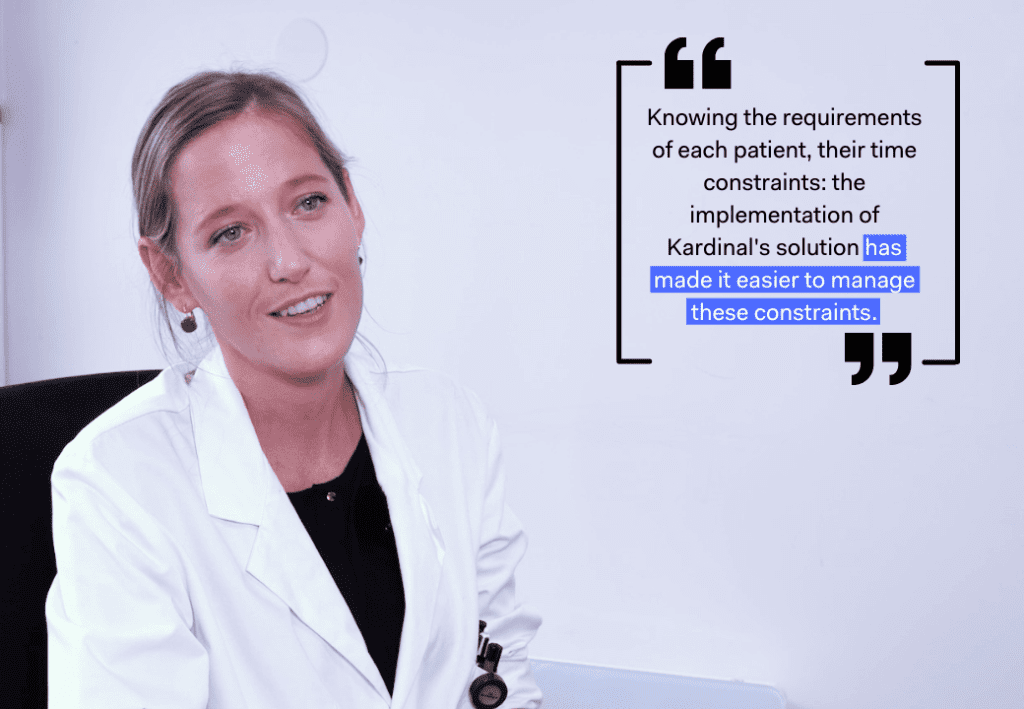Kardinal assists Cerballiance in digitizing and optimizing its business. The network of medical labs optimizes its home blood collection planning thanks to Kardinal’s software solution.
Stéphanie Kopczuk and Bastien Carrara from Cerballiance answered our questions about the implementation of this project.
Kardinal: Hello Stéphanie and Bastien, can you introduce yourselves?
Stéphanie Kopczuk: Hello, I am Stéphanie Kopczuk, Administrative Manager at the Cerballiance group for 3 years and in charge of the roll-out of Kardinal’s software solution in Eastern Paris and Saint-Blaise.
Bastien Carrara: I am Bastien Carrara, Medical Biologist at Cerballiance for 2 years and a half and I am in charge of the roll-out of Kardinal in Paris and the Ile de France East region.
K: Can you introduce Cerballiance to us?
BC: Cerballiance is a group of labs with more than 500 labs across France. The Ile de France East region alone has more than 50 labs for about 30 nurses or lab technicians performing 300 samples at patients’ homes every day.
K: How did Kardinal’s software solution become part of your daily work?
SK: Since we started using Kardinal’s solution, we have made it possible to book appointments online (for assistants, nurses and collectors). The lab manager then provides the working hours of each nurse and the algorithm then runs automatically. The next morning, collectors simply need to check their phones to see the day’s schedule, and off they go!
K: What benefits have you identified for your teams following the project’s implementation with Kardinal?
BC: The first benefit is time savings in terms of route dispatch. It used to take a lot of time for labs to prepare the routes for the next day. In addition, the samplers would need to double-check their routes in the morning.
SK: It used to take us more than an hour to schedule the 40 or so patients we had per day. Thanks to Kardinal’s solution, we save at least 1 hour every day, allowing the person in charge of this task to do something else in the lab.
The implementation of the tool has also allowed the samplers to be guided: if they are new to the area, they no longer have to worry about the itinerary. The map embedded in the mobile app allows them to be geolocated and get directions to the patient’s home. Collectors waste no time looking for directions.
With Kardinal’s solution, we can set boundaries for our collectors. Previously, they were trying to optimize their routes without calculating the number of kilometers they traveled, but now, the Kardinal solution has integrated this data and they don’t travel more than 5 kilometers each morning.
BC: The more labs use the solution, the better the algorithm gets. For example, in one region, instead of sending 30 samplers to the patients’ homes, we will send 25 or 27 instead and therefore keep staff at the lab for patients who come directly.
K: What benefits does the tool provide for your patients?
SK: The benefit for patients is that we stick to the time slots. If a patient is fasting, he will wait to be sampled early in the morning. With Kardinal’s solution, we tell the algorithm what time we want the sampler to arrive. These times are respected and for the patient this is a very positive thing.
BC: It also makes communication easier because it’s not always the nurse who knows the patients well or the same assistant who is on duty. Before Kardinal, there had to be perfect communication between everyone and that wasn’t always the case. Knowing the requirements of each patient, their time constraints, the presence of a home care worker or other: the implementation of Kardinal’s solution has made it easier to manage these time constraints.
In addition to optimizing and improving our routes, what we really value is the fact that we can estimate the time we will be visiting the patient. When a patient calls us worried because the nurse hasn’t arrived yet, we can tell them: “you’re next” or “we’ll be there in an hour or an hour and a half”. That’s really appreciated by the patients as well.
SK: If a doctor calls to add an emergency patient, we can log that into the algorithm and the software assigns the patient to the nearest sampler. The fact that the closest collector goes there allows for a much faster return to the lab and therefore faster results.
